Sumter High School has a long and rich history. What is known as Sumter High School today on McCray's Mill Road evolved over time out of several pieces that have fit together to become one high school. Those pieces include early Sumter High School (originally as separate girls's and boy's campuses), Lincoln High School, and Edmunds High School.
If you want to see where it all started on a visit to Sumter, check this location on Washington Street between West Hampton Ave. and West Liberty..."Monument Square" area.
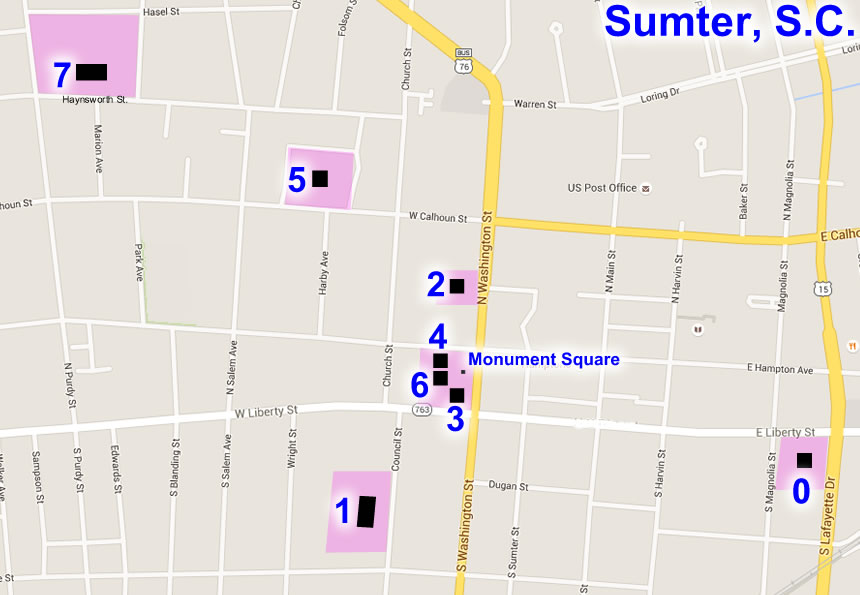
#0 - St. Joseph's Academy 1862 - 1929
#1 - Lincoln School for black students on Council St. 1874 - Lincoln School > Lincoln High School > Sumter High School
#2 - A.J. Moses Home on Washington Street. Built in 1848, burned and rebuilt 1916. Currently the Sumter Museum.
#3 - Washington School on Washington Street. 1892 - Sumter High School > Washington Elementary School
#4 - Hampton School on Hampton Street. 1903 - Sumter High School > Sumter Girls High School > Hampton Elementary School
#5 - High School on Calhoun Street. 1908 - Sumter Boys High School > Sumter Girls High School > McLaurin Jr High School
#6 - Central School on Washington Street. 1917 - Sumter Girls High School > Central Elementary School
#7 - High School on Haynsworth Street. 1925 - Sumter Boys High School > Edmunds High School > Sumter High School
The 8 schools referenced on the map and lines above include the date they were built and evolution of school name and usage.
The bold numbers referencing each school will be used throughout the content of this page.
| 1783 | The American Revolutionary War Ends | |
| 1785 | The settlement was named Sumterville after General Thomas Sumter, the "Fighting Gamecock" of the American Revolutionary War. | |
| 1805 | John Blount Miller moved to Sumterville to practice law. | |
| 1812 | The War of 1812 Begins | |
| 1815 | The War of 1812 Ends | |
| 1832 | General Thomas Sumter dies at the age of 98, the last surviving general of the Revolutionary War. | |
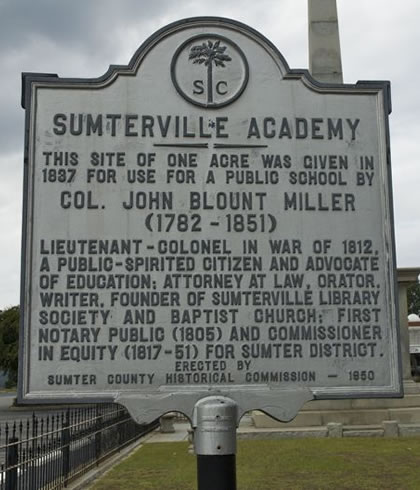
| 1837 | Col. John Blount Miller donated one acre of land on which to build the Sumterville Academy which opened that year under the direction of teacher James M. Fenn. The site consisted of the whole eastern half of the block along Washington Street, between West Liberty Street and West Hampton Ave. which later became know as Monument Square. Col. J.B. Miller was a War of 1812 veteran, lawyer, and advocate of education. He is known as the "Father of Sumterville" for his many contributions to the development of the City of Sumterville. |
| 1845 | The City of Sumterville is incorporated. | |
| 1846 | The Mexican-American War Begins | |
| 1848 | The Mexican-American War Ends | |
| 1855 | The city's name is shorted to Sumter and known throughout the state as the Gamecock City. | |
| 1861 | The American Civil War Begins | |
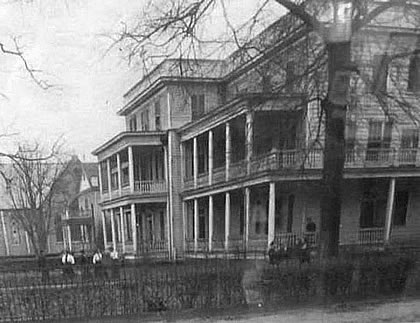 St. Joseph's Academy | 1862 | During the Civil War the bombardment of Charleston forced the Sisters of Charity of Our Lady of Mercy to move from Charleston to Sumter. In the 1862's the Sisters founded St. Joseph's Academy #0, Sumter's first educational institution. |
| 1865 | The American Civil War Ends | |
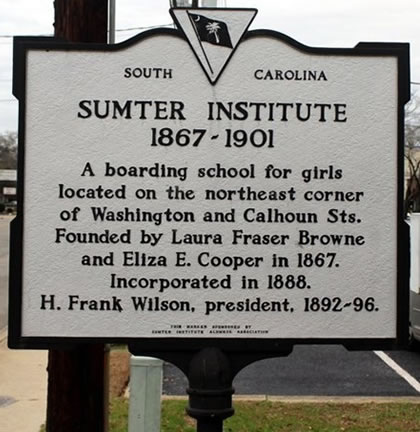 | 1867 | The Sumterville Academy was destroyed by fire and was discontinued. The Sumter Institute was founded by Laura Fraser Browne and Eliza E. Cooper in 1867 as a boarding school for girls located on the northeast corner of Washington and Calhoun Streets. This school inspired Sumter's revival from war's desolation. Beginning as a one-room day school, it became a girls' boarding academy, ranking high among South Carolina educational institutions, a center of the social, spiritual, and cultural life of the community during Reconstruction days. |
| 1871 | The City of Sumter is officially chartered. | |
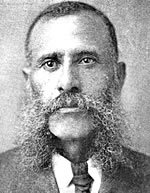 Rev. I.E. Lowery | 1874 | The first public graded school for black children was formed in Sumter when an unknown northern philanthropist granted the grounds on Council Street on which the school building known as Lincoln School #1 was to be erected. The school was a crudely constructed frame cottage, which contained four rooms entering into a passageway. Rev. I.E. Lowery was the principal and teacher for the boys and Miss M.E. Scott was the teacher for the girls. |
| 1888 | Schools in the Sumter area were private institutions that many citizens of Sumter could not afford. Due to the need for publicly funded schools The Sumter School District was formed on Christmas Eve, December 24, 1888 and a school board was elected. The Sumter Institute was also incorporated. | |
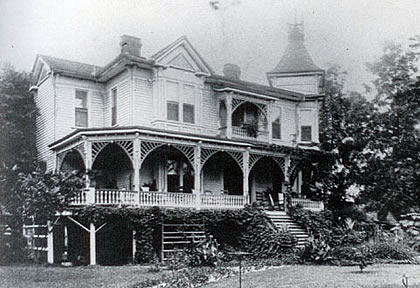 A.J. Moses School | 1889 | The first order of busines for the newly elected school board was to find a building suitable for the first public school in the new Sumter School District. The Andrew Jackson Moses home #2 on Washington Street was leased and setup as a school for white students. During July 1989 the first teachers were hired and a young, 25 year old, John B. Duffie was selected as the first superintendent of the Sumter School District. The A.J. Moses School #2, Sumter School District's first graded school, grades 1 throuth 10, opened on September 2, 1989. That same year the Lincoln School #1 for black students was brought into the newly formed Sumter School District. |
| 1890 |
The newly opened Sumter Graded School didn't have a graduating class for 1890. There were 310 white and 294 black students enrolled. There were 7 white teachers and 4 black teachers. The total operational cost for the year was $5,000 which included all salaries, lease, furnature, etc. | |
 | ||
| 1891 | The first graduating class of the new Sumter School District was the Class of 1891 with 8 students graduating. The Commencement was held on June 10, 1891. See Class 1891 - Grade 10 Commencement The A.J. Moses School had grown so overcrowded in just two years that Mr. Duffie requested that a larger permanent school building be built on the southern corner of the old site of the Sumterville Academy known as Monument Square on the corner of Washington and Liberty Streets. The land was leased for 99 years from the Ladies Monumental Society. | |
 | ||
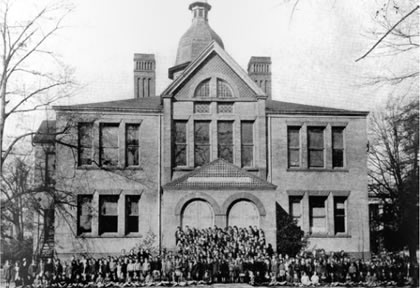 The Washington Graded School | 1892 | The new school, named Washington Graded School #3 because it faced Washington Street, opened on September 12, 1892. |
| 1893 |
| |
| 1894 |
| |
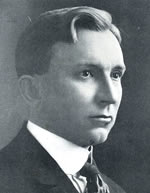 Dr. Samuel B. Edmunds | 1895 | Dr. Samuel H. Edmunds was elected by the school board to fill the poslition of Superintendent of Sumter schools to replace John B. Duffie who had resigned in June 1895 due to health issues. |
| 1897 |
Mr. John B. Duffie died Monday, October 25, 1897, at 8 o'clock in the evening at his mother-in-law's home. He had been ill for several weeks, first contracting influenza followed by pneumonia, from which he never recovered. He was only 35 years old. | |
 | ||
| 1898 |
| |
| 1899 |
| |
| 1900 |
| |
| 1901 |
| |
| 1902 |
| |
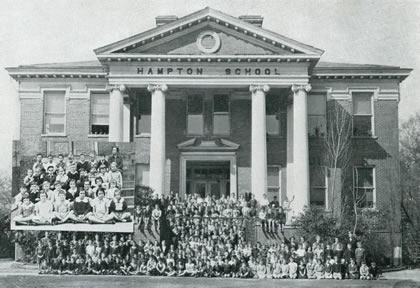 The Hampton School | 1903 | A new high school named The Hampton School #4 was added in the northwest corner of Monument Square on Hampton Avenue. The school, attended by girls and boys, had grades 7 through 10 (freshmen through seniors). |
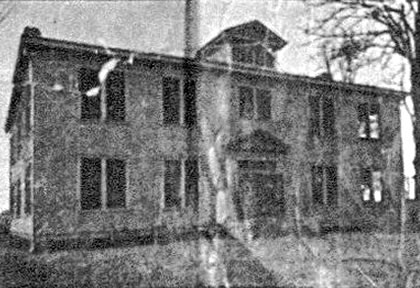 Lincoln School wooden 2-story building | 1904 | Lincoln School #1 for blacks was remodeled replacing the old single story building with a two-story building. |
| 1905 |
| |
| 1906 |
| |
| 1907 | Dr. Edmunds recognized that the city school system needed to expand the number of facilities housing white students so he recommended to the Sumter school board that a new and separate boys high school should be built and that Hampton School should become the girls high school. Washington School would be used as a primary school for both sexes. | |
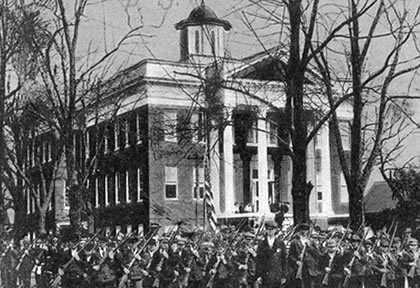 The Boys High School of Sumter on Calhoun Street | 1908 | The new Boys High School #5 was built on West Calhoun Street, between Church Street and Salem Avenue. Newspaper writeup described the rooms, building, and auditorium, as well as the fact that heating of the building is done by means of the Peck-Hammond improved system of hot air ventilators. This firm has equipped both of the other buildings (Washington, and Hampton Schools), and their system is an admirable one. This building costs about $23,000 and design was by Architect A. W. Todd of Charleston. |
 | ||
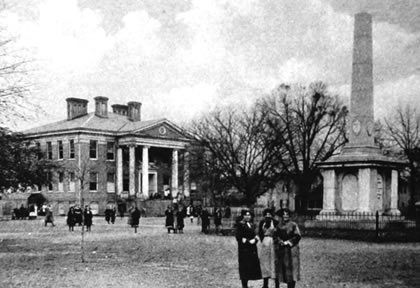 Hampton, The Girls High School and Confederate Monument | The girls all remained at the Hampton High School which was now considered The Girls High School #4. | |
| 1909 |
| |
| 1910 |
| |
| 1911 |
| |
| 1912 |
| |
| 1913 |
| |
| 1914 | 11th grade added to public schools. | |
| 1915 | Enrollment in the three schools had reached 972 students plus an 11th grade was added to the already overcrowded conditions. This led to Dr. Edmunds' proposing the construction of a fourth school to be located between Washington and Hampton schools. | |
| 1916 | Construction began on the new school estimated to cost approximately $48,615 to complete. | |
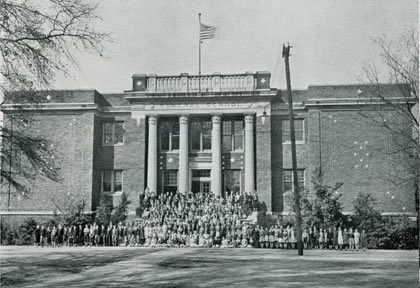 Central, The Girls High School of Sumter | 1917 | The new Girls High School #6 was completed and named Central School. It was errected between Washington School & Hampton School to make 3 school buildings on Monument Square which is probably how it got the name Central School. The Girls High School was under the principal ship of Miss Linnie McLaurin. |
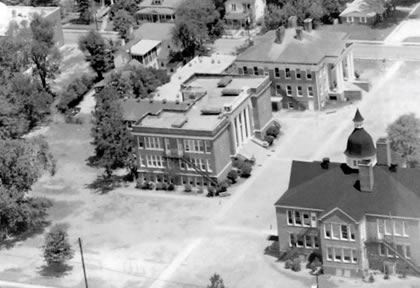 Aerial view of all three schools on Monument Square | #3 - Washington School (Bottom Right) | |
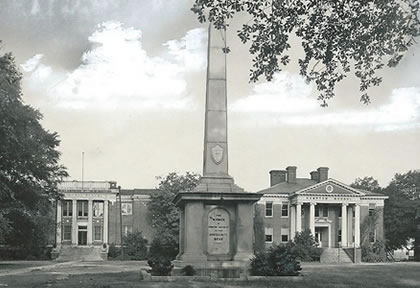 Confederate Monument with Central School (L) and Hampton School (R) | The United States enters World War I | |
| 1918 | World War I Ends | |
| 1919 |
| |
| 1920 | Sumter High School publishes it's first yearbook. | |
| 1921 | Only four years since Central School had opened, Dr. Edmunds approached the school board requesting funds again to build another high school since both of the current two high schools had quickly become severely overcrowded. Taxpayers defeated the plans to tax and fund (planned $300,000.00). Replacing and a second vote was passed by Sumterites for $285,000.00. | |
| 1922 |
| |
| 1923 |
| |
| 1924 | Land was purchased at Purdy and Haynsworth streets #7 and construction began on a new Boys High School | |
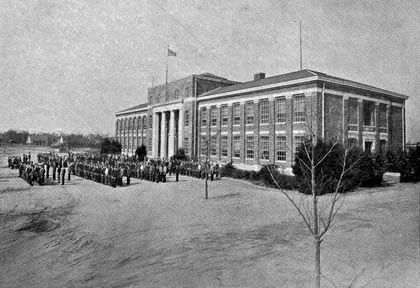 The Boys High School | 1925 | The new Boys High School #7 was completed and featured a modern laboratory allowing for instruction in biology, chemistry and physics. Several new classrooms were also added. |
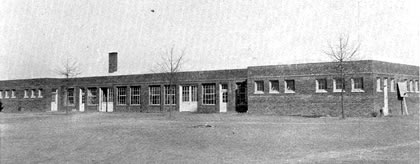 The Boys High School Workshop | The new Boys High School also featured a separate workshop building housing the latest in forges, anvils, machines, tools and motors. The workshop called the "Manual Training Building" was located directly behind the main high school building. | |
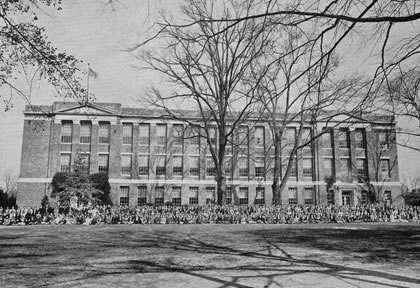 The Girls High School | The old Boys High School #5 on Calhoun Street School had burnt down so a new larger building was built on the same location for the new Girls High School. The new building had an auditorium and a combination stage-gymnasium. Physical education was added to the curricula at the Girls High School to make use of their new gymnasium. Miss Priscilla Shaw was hired to create physical education activities. Miss Shaw was highly complimented for her efforts in establishing physical education classes for each grade during the school day and a program of intramural sports held after school. Priscilla Shaw would later become mayor of Sumter. | |
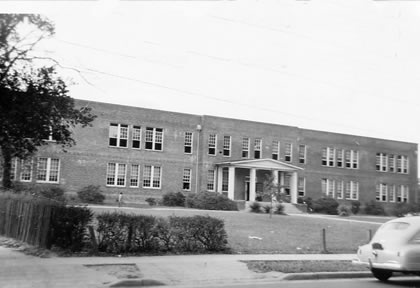 Lincoln High School | A new Lincoln High School building #1 was erected to replace the frame structure which had served the black community for more than 50 years. | |
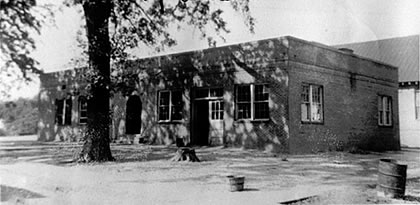 Lincoln High School Industrial Building | The new Lincoln High School also featured a separate workshop called Industrial Building in the back of the school. | |
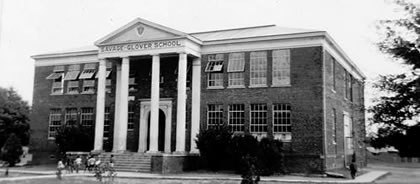 Savage-Glover Elementary School | A new elementary school for blacks was built and named Savage-Glover Elementary School after two elementary teachers, Martha Ann "Mat" Savage and Mary Elizabeth "Mamie" Glover, who taught second and third grade at the Lincoln School on Council Street. Read Savage-Grover Elementary, A Place in History | |
"New School Buildings" clipping from the Sumter Daily Item newspaper, March 6, 1925 | ||
 | ||
| 1926 | ||
| 1927 |
| |
| 1928 | ||
| 1929 | The Stock Market Crashes - August 1929 The Great Depression Begins | |
| 1930 | ||
| 1931 | ||
| 1932 | ||
| 1933 | By 1933 the Great Depression was in full swing and the US economy had reached it's lowest point. One third of all Americans were unemployed. Half of US banks had failed. The 1933 Sumter High School yearbook reflects the depressed state our country was in. With only 31 pages bound with metal staples, the 1933 yearbook was the only softbound yearbook. All other yearbooks were hardbound with hard covers. | |
| 1934 | ||
| 1935 | ||
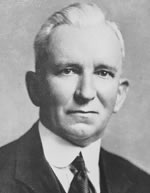 Dr. Samuel B. Edmunds | Dr. Samuel B. Edmunds died September 14, 1935 | |
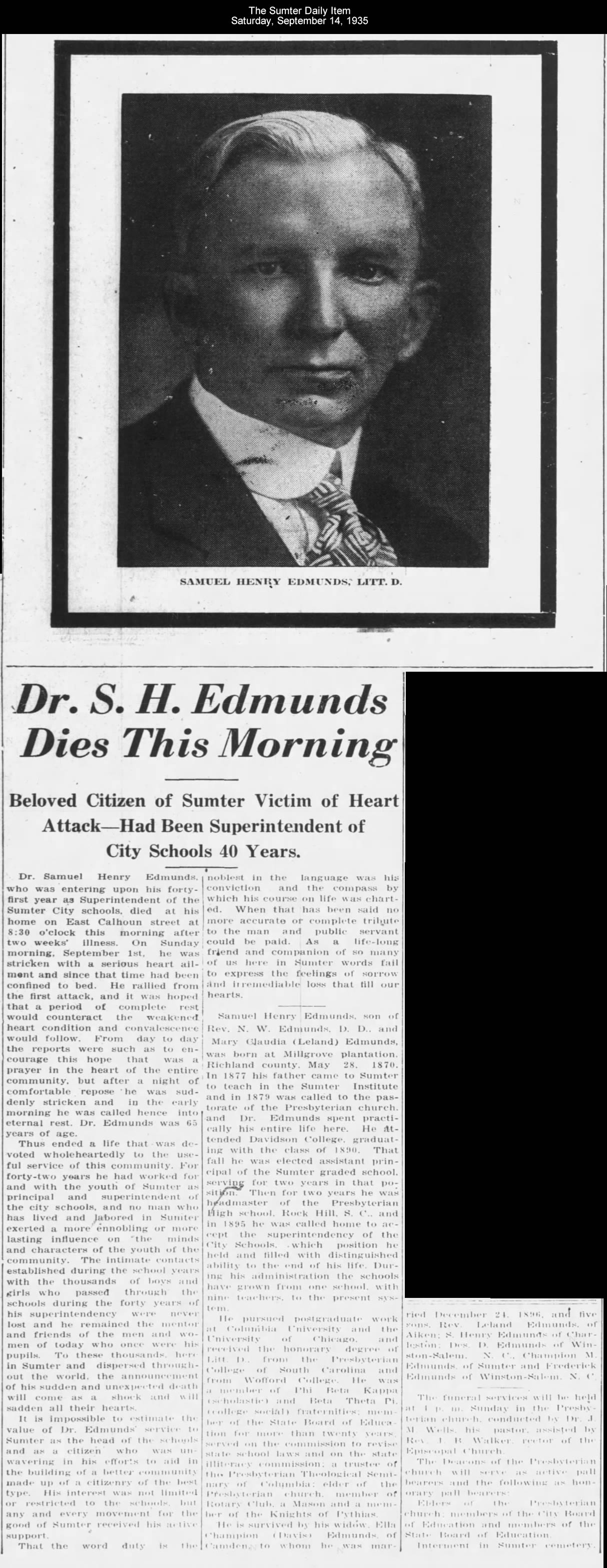 | ||
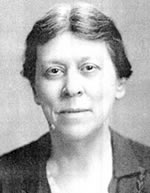 Leonora C. "Miss Linnie" McLaurin | Leonora C. "Miss Linnie" McLaurin, the principal of the Girls High School, served for a brief time as interim superintendent of Sumter Schools after Dr. Edmunds death. | |
| 1936 | ||
| 1937 | ||
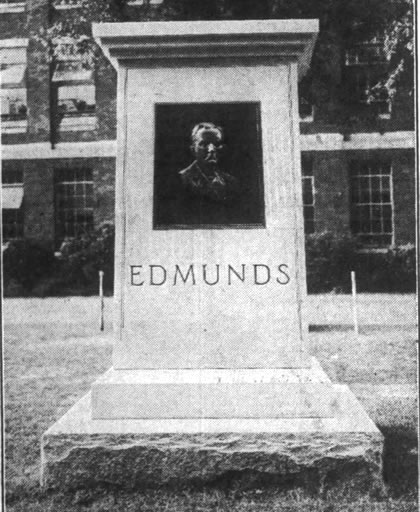 Edmunds Memorial at Girls High School on Calhoun Street | A Memorial stone, dedicated to Dr. Edmunds, was erected in the front of the Girls High School building on Calhoun Street. | |
 | ||
| 1938 | ||
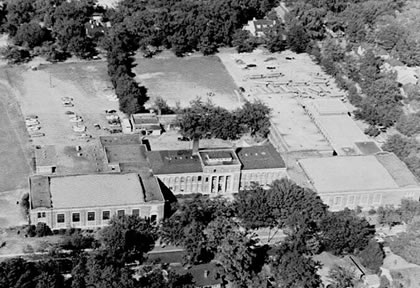 Edmunds High School with Workshop building in back | 1939 | A gymnasium, auditorium and lunch room were added the Boys High School building on Haynsworth Street at a cost of $259,000. When the 1939/40 school term opened, the newly remodeled high school was given the name Edmunds High School in honor of the late Dr. Samuel Henry Edmunds. But, the biggest change for Edmunds High School wasn't the name change or even the new additions to the building... It opened as a co-educational school. For the first time since 1908, the boys and girls were allowed to attend the same high school. The majority of the students had not been in the same building with the opposite sex since the sixth grade. |
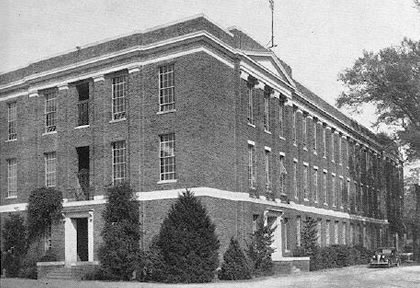 Calhoun Junior High School | The old Girls High School #5 became the Calhoun Junior High School after the boys and girls high schools merged into the one Edmunds High School building #7. | |
| 1940 | The Class of 1940 is credited with two historical milestones for Sumter. Not only were they the first graduating class of Edmunds High School, they were also the first co-ed high school class to graduate in Sumter. | |
| 1941 | Japan Bombs Pearl Harbor The United States enters World War II The Great Depression Ends | |
| 1942 | ||
| 1943 | ||
| 1944 | ||
| 1945 | 12th grade added to public schools. World War II Ends | |
| 1946 | ||
| 1947 | ||
| 1948 | ||
 Leonora C. "Miss Linnie" McLaurin | 1949 | Leonora C. "Miss Linnie" McLaurin died January 27, 1949. She taught in the Sumter City schools from 1907 until 1917 when she became the principal of the Girls High School in Sumter. She remained principal until 1935 when she took over as Superintendent of Schools upon the death of Dr. Samuel Edmunds. |
 | ||
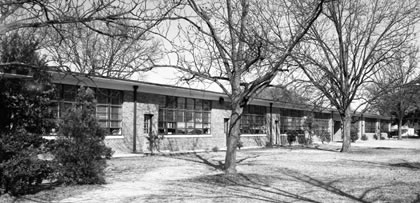 Willow Drive Elementary School | Willow Drive Elementary School opened | |
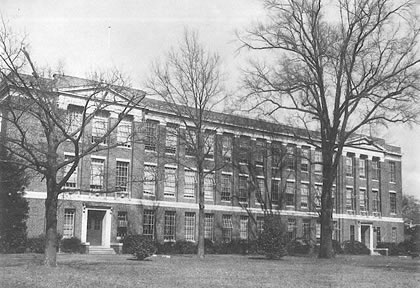 McLaurin Junior High | 1950 | The Calhoun Junior High School #5 was renamed McLaurin Junior High School after Leonora C. "Miss Linnie" McLaurin. |
 Lincoln High School | Twenty additional classrooms, a cafeteria, a gymnasium, a library and a band room were added to Lincoln High School #1. The Korean War Begins | |
| 1951 | ||
| 1952 | Lincoln High School #1 was admitted to the Southern Association of Colleges and Schools, one of the few black schools in the state of South Carolina belonging to that association. | |
| 1953 | The Korean War Ends | |
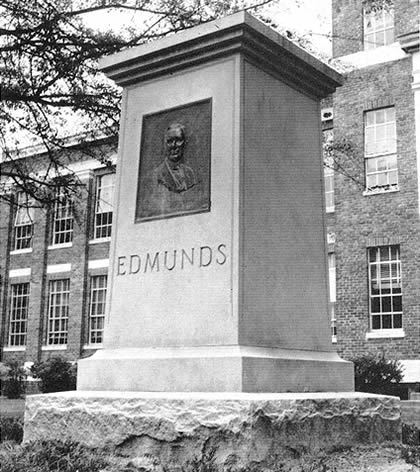 Edmunds Memorial at Edmunds High School on Haynsworth Street | The city decided to move the Edmunds Memorial stone to the Edmunds High School grounds on Haynsworth Street. Originally the stone was placed at the Girls High School on Calhoun Street in 1937. Two years later the Boys High School was renamed to Edmunds High School. The city decided that it was more suitable for the memorial to be located in front of the school named after Dr. Edmunds. "Edmunds Stone Moved" newspaper clipping from the Sumter Daily Item newspaper, November 12, 1953 | |
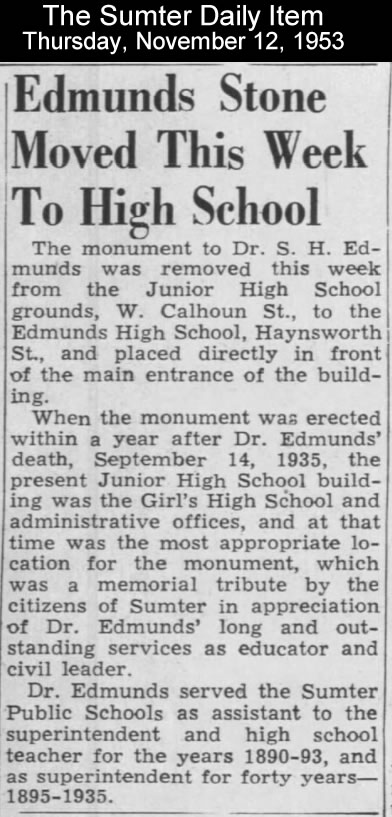 | ||
| 1954 | ||
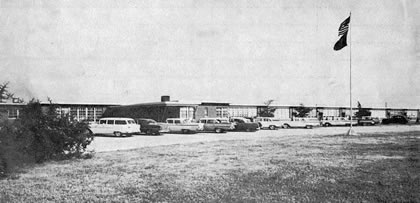 Alice Drive Elementary School | 1955 | Alice Drive Elementary School opened |
| 1956 | ||
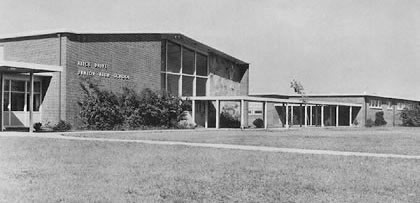 Alice Drive Junior High School | 1957 | Alice Drive Junior High School opened |
| 1958 | ||
| 1959 | ||
| 1960 | ||
| 1961 | ||
| 1962 | ||
| 1963 | ||
| 1964 | ||
| 1965 | USA sends combat troops into Vietnam | |
| 1966 | ||
| 1967 | ||
| 1968 | A new addition at Edmunds High School #7, the W.S. Jackson Wing, was completed. The added classroom space was needed to accomodate the inceased enrollment | |
| 1969 | ||
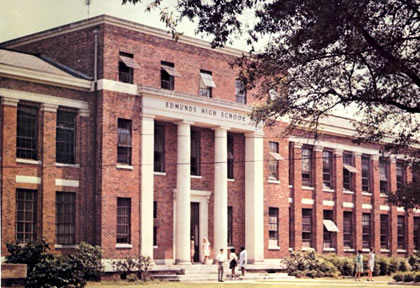 Sumter High School | 1970 | The last class to graduate from Edmunds High School was the Class of 1970. Just weeks before the start of the 1970/71 school term, Edmunds High School #7 and Lincoln High School #1 were combined to become Sumter High School #7. Because of space, classes were held at two separate campuses. The Haynsworth Street campus (formerly Edmunds High) #7 housed grades 11 and 12. The Council Street campus (formerly Lincoln High) #1 housed grade 10. |
| 1971 | The first class to graduate from the new Sumter High School #7 was the Class of 1971. | |
| 1972 | ||
| 1973 | USA pulls out of the Vietnam confict | |
| 1975 | ||
| 1976 | ||
| 1977 | ||
| 1978 | The Washington Graded School #3 is torn down. | |
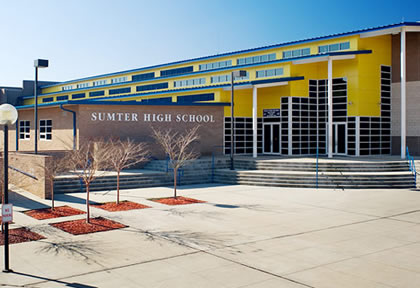 Sumter High School | 1983 | A new $11 million Sumter High School opened on McCray's Mill Road for grades 10 through 12. |
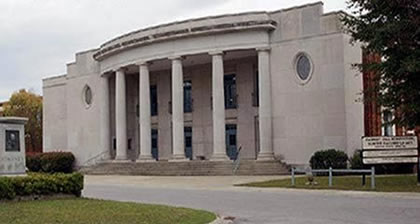 Patriot Hall (Notice the Edmunds Memorial - far left) | 1986 | The Original Edmunds High School building on Haynsworth was renovated and reopened in 1986 as the Sumter County Cultural Center, which includes the Sumter Gallery of Art, a Performing Arts Center known as Patriot Hall, and a drama theatre known as Sumter Little Theatre. The Haynsworth Street Campus also houses the Sumter County Recreation and Parks department and the Sumter School District Annex. The Edmunds memorial was left to forever remember the namesake of the great high school building that stood on this spot for over half a century. The Council Street campus now houses Trinity Lincoln Center, part of Trinity United Methodist church on Liberty Street. The McLaurin Junior High School on Calhoun Street now houses Grace Baptist Church. |
| 1987 | Sumter High School was expanded and the 9th grade was included from the Haynsworth Street campus making Sumter High School the largest high school in South Carolina. | |
| 1990 | USA enters the Gulf War | |
| 1991 | The Gulf War ends | |
| 2001 | USA enters the War in Afganistan | |
| 2003 | USA enters the War in Iraq | |
| 2004 | Sumter High School has been designated THE Model School for SC and one of thirty model schools nationwide by a national organization funded by The Bill and Melinda Gates Foundation. | |
Ancient Education History
Almost 2000 years ago, the Jews in Israel began a campaign of literacy after destruction of The Jerusalem Temple in 70AD. The non-Jewish people worldwide would lag until the fall-out from the Protestant Reformation of 1517 AD which focused on Christians being able to actually read The Bible (prior to that, ceremony and church obedience reigned supreme).
Education was a big deal to the Presbyterians who demanded not only an educated clergy but education for all so that each person could read the Bible. In fact Protestant (Presbyterian) Scotland was the first civilized nation to pass a law for public schools (1696 "Act for Setting Schools"). The College of New Jersey (later Princeton) was founded in 1736, Hampden-Sydney in Virginia in 1776, and Dickinson College in Pennsylvania in 1783.
South Carolina & Sumter Early Education Ways
It takes a lot of money to educate a population, and the South was in ruins after the War Between the States (1860-65). Individuals and churches and other entities arose to provide at least some education. But, rules and standards were slim. Time in schooling for the school year largely revolved around agricultural issues and activity. Before the 1900s, less than 30% of whites got any education in S. C., and the percentage of blacks getting any was far more dismal. Progress was very slow and hampered by a generally poor economy and social issues of all sorts.
Though provision was made in 1792 for free schools in South Carolina, there was no means set to get the money to do so. To insure some quality growth and community creation as an inland perimeter buffer to the then S. C. state capitol, Charleston, several educational institutions for whites were begun inland. That was a supplement to local personal educators/tutors (public schools were yet far off in the future). An early one was the grammar school at Salem overseen by Rev. Thomas Reese & was attended by Judge William Dobein James (later a resident of Stateburg) at the time of the seige of Charleston May 1780. Mt. Zion Institute (founded about 1790) was in Winnsboro, S.C. Winnsboro was also a summer retreat area (50-60 miles further westward/inland from Sumter). There may have also been a little community school at Salem Black River Presbyterian Church.
Small communities sent children to innumerable private schools owned and run by the teacher(s), or by "societies" of cooperating parents who employed a teacher. Education of children was a parental responsibility in early times. And when parents were too poor or indifferent, the children were illiterate.
The Clarendon (County) Orphan Academy was started about 1798 to meet this need of the poor for free. An S. C. free school law for the poor was enacted in 1811. And, by 1857, there were 52 free schools in Sumter District.
A school which prepared students for college might be called a "high school". A girls' "finishing school" might be called a "seminary". The most favored name for early schools was so-and-so "academy". Among some of the names in the Sumter area were: The Sandville Academy, Lodebar Academy, Mt. Clio Academy, Bishopville Academy, William T. Capers School, Coit's High School, Swimming Pens School, Plowden Mills School, St. Paul's Academy, Friendship Academy, Summerton Academy, Claremont Academy, and the Good Will Mills School at Dabbs Crossroads. Dr. John M. Robert's Academy (predecessor to Furman University which would relocate to current upstate location), Woodville Academy, Edgehill Academy near Stateburg, Thornton Academy, Rafting Creek Academy, The Hawthorndean Seminary, Sumterville Academy, A. J. Moses School (first public school in Sumter), Mrs. Campbell's School, The Rev. R. W. Bailey School, Orange Grove School, Bradford Springs Female Academy, Harmony Female College, "Sumter Military, Gymnastic, and Classical School", Young Ladies Seminary, Theus's Academy, The Sumterville Female Academy, the Sumterville Academy, Sumter Collegiate Institute, and Zoar Academy.
The Coming of Education for People of Color
Black schools were scarce. But, Sumter-native black leaders such as Rev. Harrison created some. Mayesville Industrial and Educational Institute (Mayesville Institute) was started about 1896 by Miss Emma Jane Wilson (her local mother was emancipated) as a school for blacks (Mary McLeod Bethune was its most famous graduate) which had 500 students in 1915. Rosenwald Schools such as Sumter's Lincoln High School and Winn Grammar School arose in the early 1900s. Goodwill Parochial School may be the area's oldest school for people of color.
Side notes
By 1915, the state of South Carolina realized that illiteracy could not be extinguished as long as children were not required to go to school. Even in white schools, 70 to 75 percent of the children never went beyond the fifth grade. Therefore, the state passed a local option law, requiring attendance between the ages of eight and fourteen. In 1921, attendance was made compulsory statewide, but there were no attendance officers to enforce the law.
As the city of Sumter grew after 1900, the public elementary schools springing up out in the county and, for various reasons, fed students into "town" after maybe 6th grade (example, Sam M. Pringle, EHS 1945, of Shaws Crossroad attended Lemira first). This varied, depending on the composition of the available county teaching faculty and the number of children in the higher grades of each county school. Or, county teachers might spot potential as in Alton J "Bo" Watts, EHS '44, with only a couple of years at Edmunds. He grew up in the Oswego area, attending schools in Mayesville until his teachers recommended that he transfer to Sumter to get better instruction in math, in preparation for entrance into Clemson, where he graduated with a degree in electrical engineering. After Shaw AFB opened in 1941, children of both native Sumterites and military families stationed for periods of time in service at Shaw might have children in the city schools for a period of time in a given, eventually graduating class, but with the child graduating in a county school (example, Robert L. Brown, EHS 1956, freshman year...9th grade...only & graduate of Hillcrest HS) or even another city & state (example, Warren O. Parkerson, EHS 1962 & moved elsewhere before high school & graduated in another state). Beginning with St. Anne Catholic School in 1954, private schools re-emerged; and many members of lower grade public schools graduated in a class year in a private school while others of their classmates remained in public schools. Thomas Sumter opened in1964 and Wilson Hall in 1966. As of 2016, there are 13 private schools in the city/county.
* Details of Superintendent John B. Duffie was replacement and of his death only two years later being replaced by Dr. Edmunds. Wilson A. McElveen, III
Mr. Duffie resigned as superintendent of the school in June 1895. Two applicants to replace him were S H Edmunds and D. L. Rambo, of Wedgefield. Mr. Edmunds, who had served as three years prior as assistant superintendent, was elected to fill the position (from June 19, 1897 edition of Watchman and Southron). Later that year, Mr. Duffie and a Mr Jones, who had worked for B J. Barnett, opened a grocery stand they bought from a Mr. L. W Joye.
According to the Oct, 27 ,1897 edition of Watchman and Southron ( Chronicling America website), Mr. John B. Duffie died at 8 o'clock Monday night at the home of his mother-in-law, Mrs. S A Brand. He had been a very sick man for several weeks and his death was not unexpected. His illness dates from last December , when he had a severe attack of grip, followed by pneumonia, form which he never recovered, but gradually grew worse until the end came and set him free from his long and painful sufferings. He was only 35 years old. He had received a degree from union college in Schenectady, NY, studied law and accepted to the bar. He had been principal of Orangeburg County schools, the Line School in Boykin and the Mayesville School.
The Graded Schools were closed the day of his funeral that was held at 1st Presbyterian Church.
References
- John Blount Miller, Father of Sumterville - by W.A. Bubba McElveen, EHS '45
- Public Schools Came in 1880 - Private Schools Were First - 09/10/1976 - Sumter Item
- Sumter County schooling history in "Reflections" (page 54) section on schools by outstanding current Sumter historian and museum developer, Sammy Way.
- A summary of Sumter County schooling history on Singleton Family Tree, by Sammy Way
- South Carolina schooling history in "The History of South Carolina Schools" edited by Virginia B. Bartels
- Lincoln High School Historical Time Line.
- Savage-Glover Elementary closed after integration, but its impact has not been forgotten - posted in the Sumter Item 6/11/1995
- Name Those Lions! - Sumter Tourism
- Encyclopedia of Southern Jewish Communities - Sumter, South Carolina
- Sumter's History - City of Sumter, SC - Gov.
- Thomas Sumter Academy Ninth to Bear Famous General's Name - 2/14/1968 Sumter Daily Item
- The Effective Truth: Shaw's of Sumter County South Carolina from 1772... "Their Story is Typical of the Times" by Ervin Bartow Shaw, Jr., M. D., EHS '62